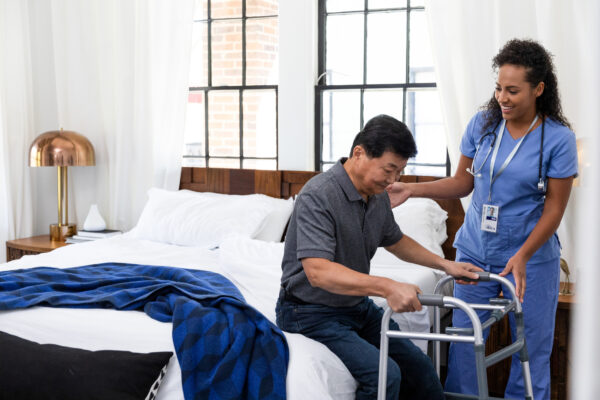
Healthcare began with the house call, and the home is where healthcare is striving to return. It’s a shift that has been underway for quite some time, but has been kicked into overdrive in recent years through new policies and technologies that make it easier and more efficient for patients to receive the care they need in the comfort of their own home.
But innovation in home-based care has been limited to care delivery. Patients who receive in-home care are constantly connected to the broader healthcare system through remote monitoring devices like blood pressure monitors, pulse oximeters, and other wearables. The caregivers who deliver their care deserve the same level of real-time connectivity.
All of the energy and resources healthcare organizations have invested in transitioning care to the home could be foiled if caregivers do not feel safe and supported in patient homes.
Home health is one of the fastest growing employment sectors. The Bureau of Labor Statistics (BLS) projects employment of homecare workers to increase 22 percent by 2032, a much faster rate of growth than the average across industries. This upward trend is converging with a troubling, ongoing crisis in healthcare: violence against healthcare workers.
Virtually any doctor, nurse, technician, or hospital staff member can share episodes of verbal or physical abuse they’ve witnessed or experienced themselves on the job. Healthcare workers account for 73 percent of non-fatal injuries from violence in the workplace, according to BLS, making them five times more likely to experience workplace violence than any other occupation. That’s just physical violence – their exposure to threats and verbal assault is much higher. These are daily experiences. And they’re not confined to hospitals.
A systematic review of academic studies on violence against home health workers found as many as 87% experience verbal abuse from patients while providing care in the home. A separate study found home health workers who have reported verbal abuse are 11 times more likely to also report physical abuse. Additional literature on this crisis suggests incidents are often under-reported, and that these episodes are associated with high turnover.
Innovative approaches to home care will only be successful if organizations can ensure the safety of the professionals who enter patient homes. To do that, they’ll need to embrace new technologies that support in-home caregivers in real-time, and implement new protocols that ensure they are provided with the security and comfort they deserve.

What Are Healthcare Organizations Getting Wrong about Email Security?
A new report by Paubox calls for healthcare IT leaders to dispose of outdated assumptions about email security and address the challenges of evolving cybersecurity threats.
Hospital-level safety in the home
American hospital campuses are sprawling, bustling mazes, and they continue to grow upward and outward with new towers, expanded wings, and wider parking complexes. Hundreds, or even thousands, of employees are working on campus at any given time, outnumbered only by patients and their loved ones.
Hospitals are a breeding ground for unpredictability, but the chaos is often tempered by security infrastructure and staffing. In some cases metal detectors at entrances and other violence prevention methods are being deployed. Further, every healthcare worker in a hospital has the added assurance of a network of colleagues in their immediate vicinity who can flag for help or even intervene when needed. Many health systems in the U.S. are also bolstering their existing security protocols with “real-time support networks” – wearable, trackable technologies that allow healthcare workers in need to signal for help.
Unfortunately the notion of a real-time support network is non-existent for caregivers traveling to patients’ homes. Every day, professionals who have dedicated their lives to delivering compassionate, high-quality care venture alone into unfamiliar territory. They don’t have security teams or colleagues nearby. They’re isolated, leaving them more exposed to aggression or violence. Their cell phone, if on-hand and reachable, is the closest thing they have to an emergency response system.
The current gaps in safety for home health workers are stark, but with the right technologies and protocols, these gaps can be bridged – keeping clinicians, nurses, and aides safe while enabling patients and healthcare organizations to fully realize the benefits of home-based care.
If wearable duress buttons can help keep nurses safe in hospitals, the same technology can be configured to work in patients’ homes, too – or wherever healthcare professionals are providing care. Some forward-looking healthcare organizations are already beginning to equip nurses, doctors, and aides with duress buttons that give them the ability to easily and discreetly alert their employer and local law enforcement with their exact location and ID and contact information in case of an emergency. This technology enables healthcare organizations and law enforcement to stage a rapid intervention, and the providers deploying it are setting the safety standard of tomorrow.
As healthcare’s homeward trajectory continues, healthcare organizations must address the unique risks and challenges it presents head-on. Safety is a basic necessity, and providing it is a practical requirement for ensuring the sustainability of home-based care. But more than that, it’s the right thing to do.
In-home care provides comfort and peace of mind for patients, and the folks delivering that care deserve the same. As the technology enabling home health continues to drive the movement forward, the future of this frontier will depend on the security of home health workers. It’s imperative for healthcare organizations to direct their innovation efforts toward keeping them safe.
Photo: SDI Productions, Getty Images
Shan Sinha is an experienced entrepreneur with deep expertise in building successful B2B SaaS and hardware companies. He’s founded multiple VC backed startups, including DocVerse (acquired by Google) and Highfive (acquired by Dialpad, having recently hit $200m ARR). DocVerse became the Google Drive desktop client. Shan has also held leadership positions at Microsoft and Google, with most of his roles focused on enterprise technologies. He is also an active angel investor and advisor to over 35 Silicon Valley startups. He has directly or indirectly been responsible for raising nearly $1B of VC funding.
He’s currently the co-founder and CEO of Canopy, who provides Canopy Protect, a cloud-based IoT service designed to help hospitals keep workers like nurses, physicians and technicians safe from patients or patient families becoming aggressive or violent. Canopy Protect is now protecting nearly 200,000 health care workers around the United States and continues to grow rapidly. Shan holds a master’s and a bachelor’s degree in computer science from MIT.
This post appears through the MedCity Influencers program. Anyone can publish their perspective on business and innovation in healthcare on MedCity News through MedCity Influencers. Click here to find out how.









